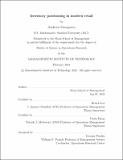Inventory positioning in modern retail
Author(s)
Georgescu, Andreea
Download1251804362-MIT.pdf (1.449Mb)
Other Contributors
Massachusetts Institute of Technology. Operations Research Center.
Advisor
Retsef Levi and Vivek Farias.
Terms of use
Metadata
Show full item recordAbstract
Modern retail has been significantly affected by the surge in online platforms and product options. Customers have comfortably settled into an omni-channel model, in which they buy different products through different channels. While customers expect a seamless process in getting the products they are looking for, they are also more influenced by the selection offered when unsure of what to buy. For retailers, the transition to omnichannel means more complex problems of inventory positioning and demand fulfillment, but also an opportunity to influence their customers through the assortments they offer, especially online. In this thesis, we study two main challenges related to inventory positioning in omni-channel and provide new models and algorithms. First, we study the problem of choice modeling and assortment optimization. Choice models aim to capture customer preferences across products and have been extensively studied. Whereas numerous models have been proposed, few are tractable, and many have been shown to be limited in capturing customer preferences, due to their underlying assumptions on consumer behavior. In the first part of this thesis, we introduce a new class of models, which we call synergistic, and show both theoretically and empirically, that these models dominate all existing ones in capturing consumer preferences. We show the associated optimization problems for the synergistic models are NP-hard, but provide IP-based algorithms, which are reasonably tractable in practice. Finally, we show that these models can be represented as ReLU activated neural networks. Therefore, state of the art methods in the neural networks field can be leveraged to efficiently estimate these models and optimize over them, to inform assortment optimization decisions. In the second part of the thesis, we focus on inventory planning for a physical retailer, considering the complex dynamics in the store involving the backroom, and the need to minimize its use. The question is motivated by our collaborator, a large US retail chain, striving to leverage their store assets as shipping hubs. We present a case study of working with real data to understand the complexities of this question and identify steps a retailer can take to become leaner.
Description
Thesis: S.M., Massachusetts Institute of Technology, Sloan School of Management, Operations Research Center, February, 2021 Cataloged from PDF version of thesis. Includes bibliographical references (pages 119-122).
Date issued
2021Department
Massachusetts Institute of Technology. Operations Research Center; Sloan School of ManagementPublisher
Massachusetts Institute of Technology
Keywords
Operations Research Center.